 The Two Micron All Sky Survey at IPAC
The Two Micron All Sky Survey at IPAC
![]()
 The Two Micron All Sky Survey at IPAC
The Two Micron All Sky Survey at IPAC
|
|
|
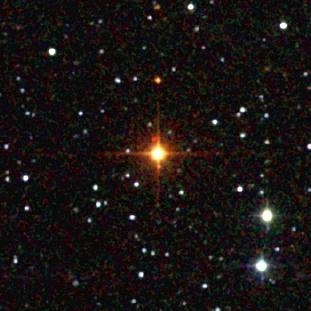 The carbon star IRAS 05316+1757.
(Field size 5.8´ × 5.8´. Image size 152 kb.)
The carbon star IRAS 05316+1757.
(Field size 5.8´ × 5.8´. Image size 152 kb.)
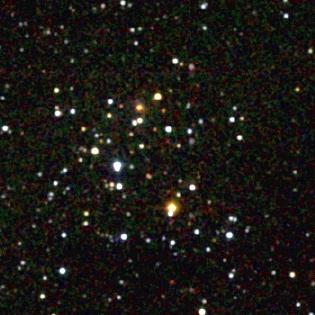 IRAS 05489+2733.
(Field size 5.8´ × 5.8´. Image size 152 kb.)
IRAS 05489+2733.
(Field size 5.8´ × 5.8´. Image size 152 kb.)
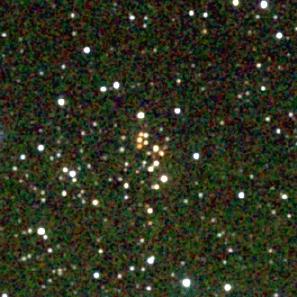 IRAS 06063+2456.
(Field size 5.5´ × 5.5´. Image size 150 kb.)
IRAS 06063+2456.
(Field size 5.5´ × 5.5´. Image size 150 kb.)
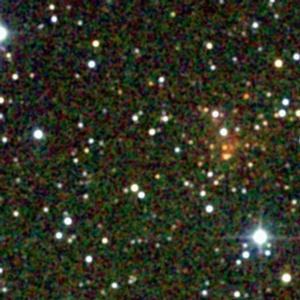 IRAS 06065+2124.
(Field size 5.0´ × 5.0´. Image size 136 kb.)
IRAS 06065+2124.
(Field size 5.0´ × 5.0´. Image size 136 kb.)
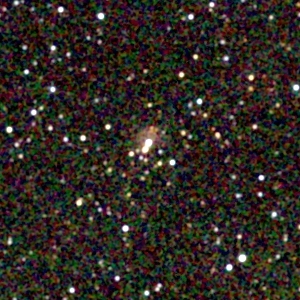 IRAS 06067+2055.
(Field size 5.0´ × 5.0´. Image size 141 kb.)
IRAS 06067+2055.
(Field size 5.0´ × 5.0´. Image size 141 kb.)
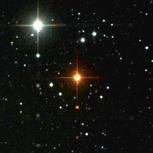 Atlas Image Mosaic of the carbon star
IRAS 06088+1909. Carbon stars are evolved stars, similar to the Sun,
which are nearing the ends of their lives, in the so-called asymptotic giant
branch phase. Many form dusty, carbon-rich envelopes, due to mass loss, which
makes the very red in color, especially in the near-infrared. IRAS 06088+1909
is a very dusty carbon star toward the Galactic anticenter (Jura & Kleinmann
1990, ApJ 364, 663). 2MASS is particularly sensitive to carbon stars.
Liebert et al. (2000, PASP, 112, 1315) report on several very cool carbon
stars in or beyond the Galactic halo, some of which are heavily dust
enshrouded. They conclude that 2MASS can be used to define a useful sample
of carbon stars at high Galactic latitude as tracers of the halo out to
distances comparable to the Magellanic Clouds.
In the 2MASS image, the fainter reddish "stars"
immediately east of due north and west of due south of both IRAS 06088+1909
and the bluer bright star to its northeast are known 2MASS "filter glint"
artifacts; known diffraction spike and persistence artifacts are also seen
associated with these two bright stars.
Image mosaic by S. Van Dyk (IPAC).
(Field size 7.0´ × 7.0´. Image size 175 kb.)
Atlas Image Mosaic of the carbon star
IRAS 06088+1909. Carbon stars are evolved stars, similar to the Sun,
which are nearing the ends of their lives, in the so-called asymptotic giant
branch phase. Many form dusty, carbon-rich envelopes, due to mass loss, which
makes the very red in color, especially in the near-infrared. IRAS 06088+1909
is a very dusty carbon star toward the Galactic anticenter (Jura & Kleinmann
1990, ApJ 364, 663). 2MASS is particularly sensitive to carbon stars.
Liebert et al. (2000, PASP, 112, 1315) report on several very cool carbon
stars in or beyond the Galactic halo, some of which are heavily dust
enshrouded. They conclude that 2MASS can be used to define a useful sample
of carbon stars at high Galactic latitude as tracers of the halo out to
distances comparable to the Magellanic Clouds.
In the 2MASS image, the fainter reddish "stars"
immediately east of due north and west of due south of both IRAS 06088+1909
and the bluer bright star to its northeast are known 2MASS "filter glint"
artifacts; known diffraction spike and persistence artifacts are also seen
associated with these two bright stars.
Image mosaic by S. Van Dyk (IPAC).
(Field size 7.0´ × 7.0´. Image size 175 kb.)
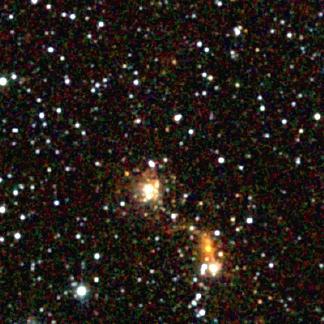 IRAS 06103+1523/4.
(Field size 6.7#180; × 6.7´. Image size 201 kb.)
IRAS 06103+1523/4.
(Field size 6.7#180; × 6.7´. Image size 201 kb.)
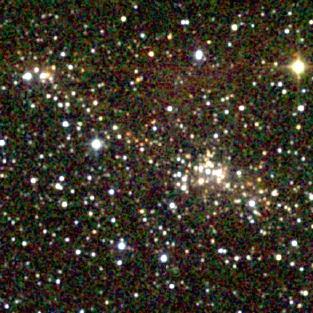 IRAS 06117+1901.
(Field size 7.2#180; × 7.2´. Image size 241 kb.)
IRAS 06117+1901.
(Field size 7.2#180; × 7.2´. Image size 241 kb.)
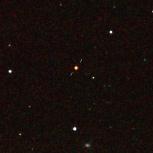
IRAS SSC08546+1732, a faint heavily dust-enshrouded carbon star at high
galactic latitude in the IRAS Serendipitous Survey Catalog (see Cutri et al.
1989, AJ, 97, 866). The star has no optical counterpart on the Digitized
Sky Survey. The latitude and faintness of this star imply that it is in the
Galactic halo, and either evolved from a Pop I precursor ejected from the
Galactic disk or is a obscured halo carbon star of Pop II.
(Field size 8.3´ × 10.5´. Image size 250 kB.)
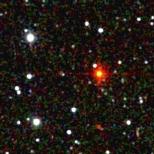 The star OH 345.0+15.7 (AFGL source GL 1822; IRAS 16029-3041) is an OH
(hydroxyl) line emitter and
has no optical counterpart. It is likely a late M-type star
with a very dense dusty circumstellar envelope at a distance of about 6 kpc
(19600 light years) from us. It is losing its mass at a
rate of 1.4 × 10-4 solar masses per year, implying that it
is in a superwind phase at the tip of the asymptotic giant branch (Persi et
al. 1990, A&A, 237, 153). The wind is moving out from the star at about 13
km/sec. Persi et al. in 1985 June found a K magnitude of 6.82 for the star
(the 2MASS Ks magnitude is 6.87 ± 0.02; the 2MASS color
is J-Ks=8.72).
The OH/IR star is likely nearing the end of its life.
The red "stars" trailing to the south in decreasing brightness are
ghost artifacts of the bright OH/IR star.
(Field size 4.0´ × 6.6´. Image size 141 kB.)
The star OH 345.0+15.7 (AFGL source GL 1822; IRAS 16029-3041) is an OH
(hydroxyl) line emitter and
has no optical counterpart. It is likely a late M-type star
with a very dense dusty circumstellar envelope at a distance of about 6 kpc
(19600 light years) from us. It is losing its mass at a
rate of 1.4 × 10-4 solar masses per year, implying that it
is in a superwind phase at the tip of the asymptotic giant branch (Persi et
al. 1990, A&A, 237, 153). The wind is moving out from the star at about 13
km/sec. Persi et al. in 1985 June found a K magnitude of 6.82 for the star
(the 2MASS Ks magnitude is 6.87 ± 0.02; the 2MASS color
is J-Ks=8.72).
The OH/IR star is likely nearing the end of its life.
The red "stars" trailing to the south in decreasing brightness are
ghost artifacts of the bright OH/IR star.
(Field size 4.0´ × 6.6´. Image size 141 kB.)
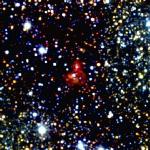 Atlas Image mosaic of IRAS 17244-3536, which
appears to be a region of high gas density and a source of
CS molecular emission (Chan, Henning, & Streyer 1996, A&AS, 115, 285),
where one or more young massive stellar objects are forming.
Little else is known about IRAS 17244-3536.
Image mosaic by S. Van Dyk (IPAC).
(Field size 6´ × 6´. Image size 278 kb.)
Atlas Image mosaic of IRAS 17244-3536, which
appears to be a region of high gas density and a source of
CS molecular emission (Chan, Henning, & Streyer 1996, A&AS, 115, 285),
where one or more young massive stellar objects are forming.
Little else is known about IRAS 17244-3536.
Image mosaic by S. Van Dyk (IPAC).
(Field size 6´ × 6´. Image size 278 kb.)
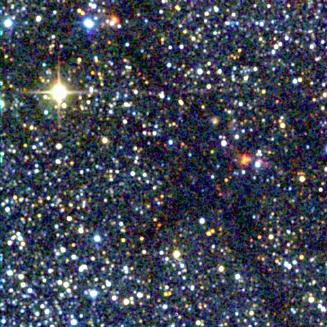 IRAS 19270+1750.
(Field size 8.3#180; × 8.3´. Image size 323 kb.)
IRAS 19270+1750.
(Field size 8.3#180; × 8.3´. Image size 323 kb.)
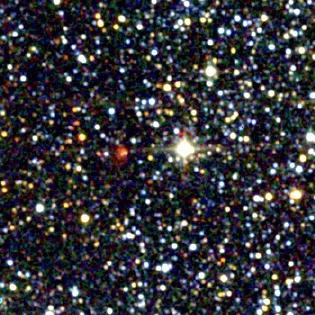 IRAS 19253+1748.
(Field size 5.8#180; × 5.8´. Image size 176 kb.)
IRAS 19253+1748.
(Field size 5.8#180; × 5.8´. Image size 176 kb.)
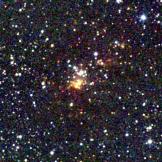 The embedded young star cluster IRAS 20050+2720,
the bright agglomeration of stars near the center of
the 2MASS three-color image. This cluster has been recently
studied by Chen et al. (1997, ApJ, 475, 163). The cluster appears to consist
of several subclusterings, three of which were studied by Chen et al.; there
appear to be several other subclusterings not included in their near-IR
imaging. The IRAS source itself is the
brightest, reddest southern subclustering ("Subcluster A").
Some reflection nebulosity is
associated with the cluster stars. Chen et al. find an extinction to
the cluster of AV ~ 10, although the extinction is clearly higher
for subcluster A. (It is also clear from the 2MASS image that
significant extinction is distributed throughout this field.)
More than half of the point sources in the
cluster appear to show an infrared excess beyond this extinction,
indicating that we may be seeing thermal dust emission from circumstellar disks
around classical T Tauri stars. These sources are therefore likely pre-main
sequence objects. Chen et al. find that the slope and turnover of the K-band
luminosity function imply an overall age for this cluster of ~1 Myr, although
the subclusters are of somewhat different ages. The IRAS source
"subcluster A" is also associated with dense molecular gas as traced by
millimeter radio observations and coincides with the center of
a multipolar outflow with a dynamical age of only 103 to
104 yr.
(Field size 8.2´ × 14.5´. Image size 511 kB.)
The embedded young star cluster IRAS 20050+2720,
the bright agglomeration of stars near the center of
the 2MASS three-color image. This cluster has been recently
studied by Chen et al. (1997, ApJ, 475, 163). The cluster appears to consist
of several subclusterings, three of which were studied by Chen et al.; there
appear to be several other subclusterings not included in their near-IR
imaging. The IRAS source itself is the
brightest, reddest southern subclustering ("Subcluster A").
Some reflection nebulosity is
associated with the cluster stars. Chen et al. find an extinction to
the cluster of AV ~ 10, although the extinction is clearly higher
for subcluster A. (It is also clear from the 2MASS image that
significant extinction is distributed throughout this field.)
More than half of the point sources in the
cluster appear to show an infrared excess beyond this extinction,
indicating that we may be seeing thermal dust emission from circumstellar disks
around classical T Tauri stars. These sources are therefore likely pre-main
sequence objects. Chen et al. find that the slope and turnover of the K-band
luminosity function imply an overall age for this cluster of ~1 Myr, although
the subclusters are of somewhat different ages. The IRAS source
"subcluster A" is also associated with dense molecular gas as traced by
millimeter radio observations and coincides with the center of
a multipolar outflow with a dynamical age of only 103 to
104 yr.
(Field size 8.2´ × 14.5´. Image size 511 kB.)
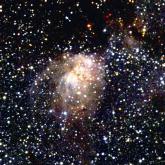 Atlas Image mosaic of IRAS 20306+4005, an object
in the Infrared Astronomical Satellite (IRAS) catalog of sources. Little is
known about this object, but it appears to be a region of current massive star
formation in the Galactic plane and near the Cygnus 0B2 stellar association.
This is the first known near-infrared image of this source. Infrared-bright
filaments of gas surround a young cluster of stars and young stellar objects
still embedded in their natal dusty molecular cloud.
A large patch of heavily-obscuring dust is seen to the
north of the nebula. 2MASS is ideal for investigating the nature of many IRAS
objects and other very young star-forming regions throughout the Galaxy.
Image mosaic by S. Van Dyk (IPAC). These data are included in the Second
Incremental Release!
(Field size 15.3´ × 17´. Image size 988 kb.)
Atlas Image mosaic of IRAS 20306+4005, an object
in the Infrared Astronomical Satellite (IRAS) catalog of sources. Little is
known about this object, but it appears to be a region of current massive star
formation in the Galactic plane and near the Cygnus 0B2 stellar association.
This is the first known near-infrared image of this source. Infrared-bright
filaments of gas surround a young cluster of stars and young stellar objects
still embedded in their natal dusty molecular cloud.
A large patch of heavily-obscuring dust is seen to the
north of the nebula. 2MASS is ideal for investigating the nature of many IRAS
objects and other very young star-forming regions throughout the Galaxy.
Image mosaic by S. Van Dyk (IPAC). These data are included in the Second
Incremental Release!
(Field size 15.3´ × 17´. Image size 988 kb.)
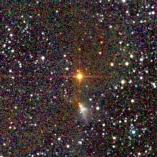 Atlas Image mosaic of the infrared source
IRAS 22051+5848, seen south of center in the 2MASS image. This source,
at a distance of about 750 pc (2445 light
years), is a pre-main sequence star reaching the end of an active FU Orionis
phase and is embedded in the dark cloud LDN 1165. The fan-like nebula
immediately to the southwest is GY 22, and is likely a reflection
nebula, scattering light from IRAS 22051+5848. The IRAS source is also
the origin of Herbig-Haro (HH) object 354 (not seen in the 2MASS image), an
outflow which is unusually separated by a large distance (2.4 pc, or 7.8 light
years) from its source (Reipurth, Bally, & Devine 1997, AJ, 114, 2708). The
brighter reddish star at the center of the 2MASS image is IRAS 22051+5849,
which is also embedded in the same cloud, but is unlikely the source of HH 354.
Image mosaic by S. Van Dyk (IPAC).
(Field size 8.0´ × 8.0´. Image size 293 kb.)
Atlas Image mosaic of the infrared source
IRAS 22051+5848, seen south of center in the 2MASS image. This source,
at a distance of about 750 pc (2445 light
years), is a pre-main sequence star reaching the end of an active FU Orionis
phase and is embedded in the dark cloud LDN 1165. The fan-like nebula
immediately to the southwest is GY 22, and is likely a reflection
nebula, scattering light from IRAS 22051+5848. The IRAS source is also
the origin of Herbig-Haro (HH) object 354 (not seen in the 2MASS image), an
outflow which is unusually separated by a large distance (2.4 pc, or 7.8 light
years) from its source (Reipurth, Bally, & Devine 1997, AJ, 114, 2708). The
brighter reddish star at the center of the 2MASS image is IRAS 22051+5849,
which is also embedded in the same cloud, but is unlikely the source of HH 354.
Image mosaic by S. Van Dyk (IPAC).
(Field size 8.0´ × 8.0´. Image size 293 kb.)
Return to 2MASS Image Gallery Homepage